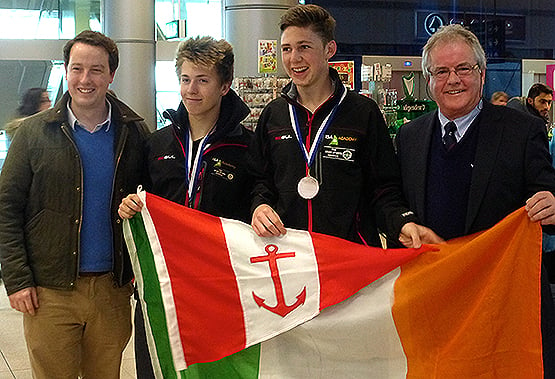Displaying items by tag: HYC
SB20s Stage Howth Yacht Club Coaching Clinic, Launch New Website
An opportunity to clarify your sailing decisions will be provided by the Irish SB20 class association when it stages a racing strategy clinic run in conjunction with the Howth Yacht Club Spring Warmer Series in April.
The sportsboat class has also launched a new website for the 2016 season. Click here to see the new site.
The new coaching initiative from 9-16th April will take place during HYC racing and outside assistance will be permitted in the series to facilitate coaching.
SB20 sailor Jimmy Dowling says it is a 'great opportunity to hone decision making skills under the guidance of world renowned coach, Mark Rhodes'.
Areas covered include:
● The three segments of the first beat (The Law of Before)
● Creating a starting priority list = creation of strategy = start
● 5 key areas to position at the start (with additional one extra)
● Double tacking – How, why, when
● Fleet / boat control – How, why, when, where
The cost per boat is €100
The annual SB20 class dinner will be held upstairs in the dining room of the Royal Irish Yacht Club on Friday 4th March (19:30hrs for 20:00hrs). The 3 course dinner is €35pp.
How Ireland Won Bronze At the Youth Sailing Worlds
As a vehicle sport dominated by weather conditions, sailing can be difficult enough to explain to the outside world. But when you factor in the constantly changing situation which is youth sailing, where crew dynamics of size, weight and attitude can change with bewildering rapidity, it becomes very complex indeed.
Yet despite the inevitable fluidity, Ireland has long had a vibrant youth sailing scene. And it’s on a roll right now, with the Irish crew of Doug Elmes and Colin O’Sullivan returning this week from the Youth Worlds on the other side of the planet with a Bronze Medal in the 420, while the bonus is that all of the team of four came home from the championship with very solid performances recorded. Liam Glynn returned with 15th out of a fleet of 66 in the Laser Radial Boys, while Aisling Keller was tenth out of 55, also in Laser Radial. W M Nixon tries to capture the mood of the moment, and the machinations behind the 420 crew’s special success.
It could well be that there was only a window of opportunity of maybe six months or even less in which Doug Elmes of Kilkenny and Colin O’Sullivan of Malahide could have been realistically in the frame for a podium place racing the 420 in the Youth Sailing World at Langkawi in Malaysia in the final week of 2015.
The 420 is a gallant little boat, but young sailors outgrow them very quickly. And then before you know it, they’re too old anyway. Elmes, who is now 17, and O’Sullivan, who will become 17 in March, have known each other, and got on well together, since they first met while racing Optimists when aged eleven. But it wasn’t automatic that they should team up to sail 420s, instead of choosing the usual solo junior sailing career path of going on to maybe a year or two in Toppers, and then on into the Laser.
Sailing pundits bewail the fact that our junior sailing is dominated by single-handed boats. But the logistics of campaigning a two-person boat on the national and international circuit at junior level are extremely challenging. The most basic problem is that neither crewmember will have a driving licence. Thus they’re totally reliant on family or organisational support for boat movement, and in the end it almost invariably means that two families will be totally involved.
The level of mutual goodwill required across the generations and between at least two households is extremely high, so it’s not surprising that ISA Coach Ross Killian – he marks ten years as a fulltime sailing coach this year – reckons that a realistic figure for the Irish 420 fleet with genuine potential hovers around the 15 mark, and the going is good when the number of serious participants gets up to 20 boats.
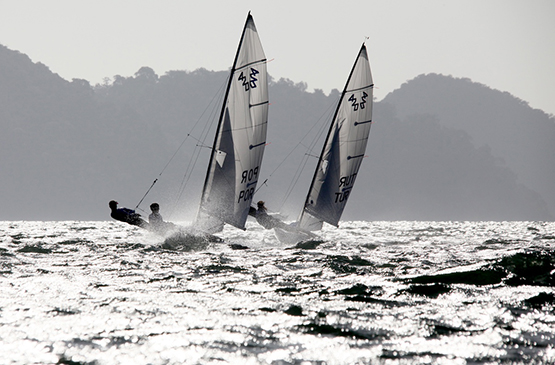
A sailing paradise. The Portuguese and Turkish crews revelling in the perfect 420 sailing conditions at Langkawi.

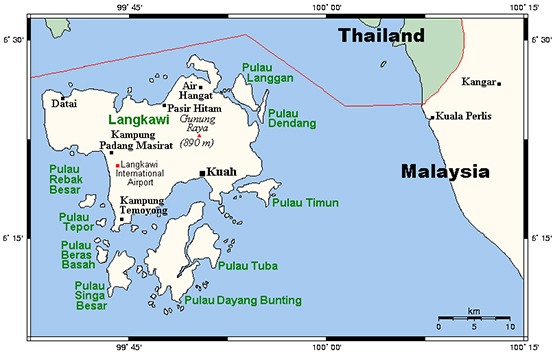
The paradise island provided one problem - getting the boats delivered there had a significant “Just In Time” aspect.
In such a small fleet, inevitably the volunteer administrative work will fall to a few. You get a notion of the compact size of the national operation when you realize that the Irish President is John Elmes of Waterford Harbour SC in Dunmore East, who also happens to be Doug Elmes’ father, while the Class Secretary is Joan O’Sullivan of Malahide who – you’ve guessed it – is Colin O’Sullivan’s mum.
Yet as regular Afloat.ie watchers will be well aware, on Tuesday when the successful team returned to a rapturous welcome in Dublin Airport, the 420 crew found themselves immediately wrapped in the tricolour and the Howth YC burgee, and it’s in the Howth club tomorrow that they’ll be officially welcomed home.
This neatly illustrates the fact that the Irish 420 focal point is a moveable feast. For now at any rate, it’s Howth which happens to be providing the national centre. It is currently coming up with the numbers, and in club coach Graeme Grant it has one very talented individual who inspires the young people to reach the level at which they can be taken under Ross Killian’s wing for the international circuit.
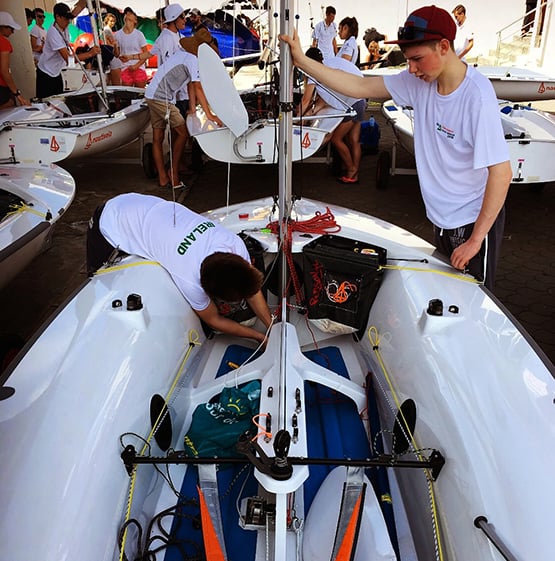
Colin O’Sullivan holds the mast in place as the 420s are rigged and Doug Elmes turns his skills to sorting a technical problem on the boat, which was delivered to the venue at the last moment. Photo: Ross Killian
But it’s a matter of catching the talent when all the stars have the potential to be in alignment, and in the final analysis it’s the young crews themselves who have to show the spark that will be fanned into the flame of success.
Of the successful crew, it was Colin O’Sullivan who first felt the 420 urge. He remembers it very well. He was thirteen-and-a-half at the time, and though he could have had another couple of years with the Optimists, he was growing tall, and so he got involved with 420 sailing, crewing for Ewan McMahon of Howth.
Meanwhile Doug Elmes – who had been concentrating on sailing Optimists at Crosshaven with the RCYC - was soon feeling the same way, and he in turn teamed up to move on to 420 racing with Bill Staunton of Skerries, which tells us something of the truly national nature of Optimist racing.
But when we look at the 420 in detail, it’s to realise that while she’s a very serviceable little boat, the fact that she’s precisely and only 4.2 metres long makes it inevitable that with today’s bigger and faster-growing youngsters, their 420 compatibility period can be very brief indeed, and they have to keep an eye out for potential new crewmates.
Thus when MacMahon and Staunton outgrew the 420, Elmes and O’Sullivan decided to become a crew, and their debut together was at Wexford in September 2014. They’ve been fine-tuning their act ever since, with the busy little class at Howth providing the stage, and they make for a very balanced duo in a boat which is central to world youth sailing.
The virtue of the 420 is that she’s as small and economical as you can get while still having the crew on a trapeze. The boat has been around for more than half a century now, having been designed by Christian Maury to a specification devised by the chief instructors at a sailing school in southwest France. But as she’s one of those boats that looks much better when fully alive and sailing well than she does on the plans, it took a long time in the 1970s before anyone in Ireland would accept the contention, put forward by Sean Clune of the National YC, that the 420 was the only way to go for Irish junior sailing.
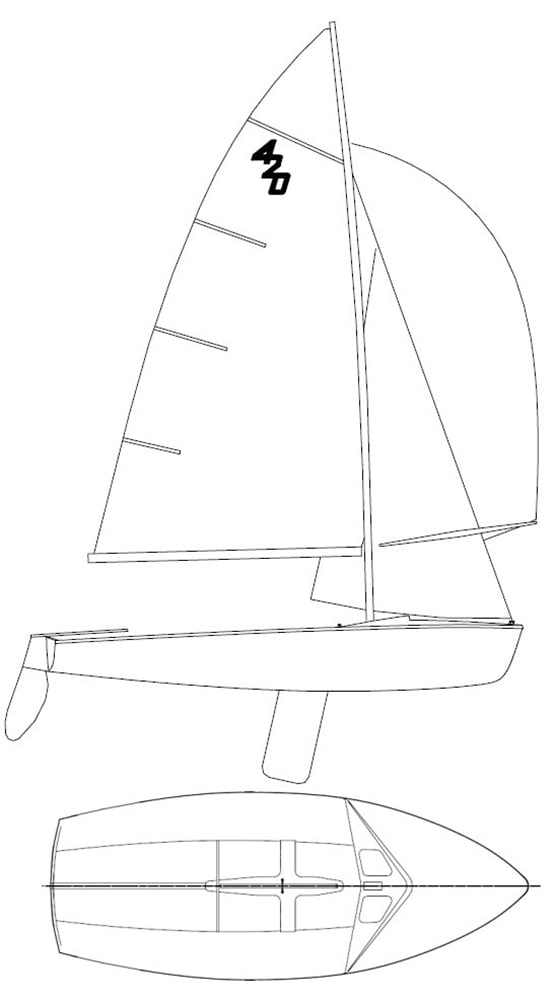
The International 420 is one of those boats which looks better when she’s sailing (below) than she does on the plans (above)

But for those young people who wanted a boat which was minimum hassle to maintain yet providing a proper grown-up sailing experience, the 420 was the future here and now, and it has the advantage of being family-friendly in that, though you’ll need the help of your folks to get the boat to a championship destination, they won’t have to shell out on a 4X4 for a towing vehicle, while it has long been a class tradition that at major international events, the host nation has to provide boats.
So all you have to do is provide the talent and the dedication……Well, there’s more to it than that, of course. But for now, let’s just celebrate the fact that a young sailor from Ireland’s only significant inland town which is not an official waterways port, teamed up moreover with another young sailor who learned his skills on the unique Broadmeadow Water at Malahide, has done the business on the sunny seas of southeast Asia with coolness and style.
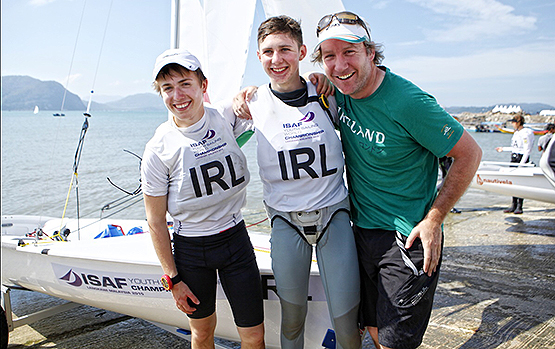
The job done – with their Bronze Medal secured, Doug & Colin get together with coach Ross Killian.
It was classic stuff. As Graeme Grant says of their development: “They have been always improving results and skills through dedication and hard work”. And as Ross Killian attests: “They’re just so cool under pressure, and they balance each other”.
As Colin O’Sullivan loyally asserts, it’s Doug Elmes who is the techno-genius. They arrived in the island of Langkawi to find paradise and perfect sailing conditions – but no boats. There’d been a foul-up in the fleet delivery schedule. The boats arrived at the last minute, so the trial race was the very first sail. But Doug was in his element putting it all together, and their boat was as race prepared as any in the fleet.
As the series progressed, it came down to the wire for the Bronze Medal between Ireland and Australia. In the crucial race, it was the Australian coach who commented to Ross Killian on the stylish coolness of the Irish crew, and watched in open-mouthed admiration as Elmes carried off a mark-rounding with such skill that he picked up three places at a stroke.
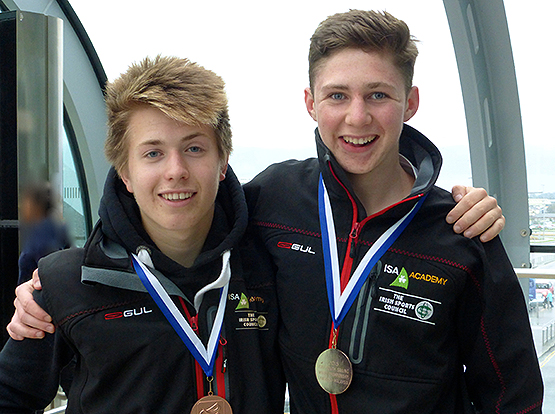
Thereafter, the commentators on the shared coach-boat were favourably impressed by the way the Irish kept the race and their place under quiet yet total control, avoiding the temptation to throw everything away by being unnecessarily greedy.
The day after their return to Ireland, we spoke with Colin O’Sullivan after he’d done some serious catching-up on sleep, yet with typical dedication had dragged himself out into the winter night for his routine session at the gym. The big question with a crew of two is how much they talk during a race. The answer in this case is that since teaming up less than 18 months ago, the Elmes-O’Sullivan crew have upped the talk level with every event, yet it has become more focused each time out. “At Langkawi, we were exchanging information all the time, the talk was constant” says O’Sullivan with a chuckle, “but you definitely wouldn’t call it chat”.
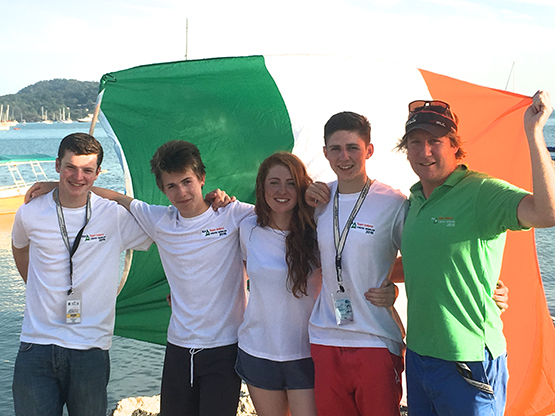
At the conclusion of a good Youth Worlds for Ireland are (left to right) Liam Glynn, Doug Elmes, Aisling Keller, Colin O’Sullivan and Ross Killian.
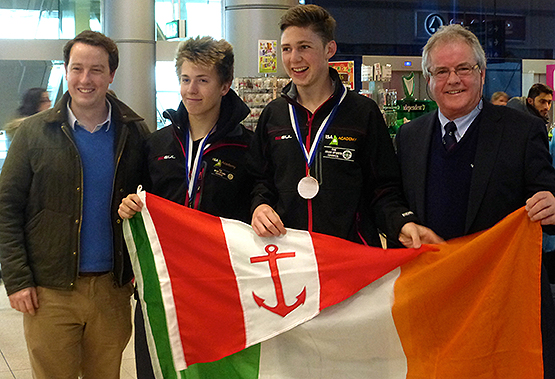
Ireland’s Youth Sailing Team Returns Home With Bronze Medal
The traditional midwinter festive air of Dublin Airport returned briefly but vividly today when Ireland’s team in the Youth Sailing Worlds came home in triumph from Langkawi in Malaysia bearing the Bronze Medal won in the International 420 by Douglas Elmes (17) and Colin O’Sullivan (16).
There to provide a rapturous welcome were family and friends, together with Howth YC Commodore Berchmans Gannon and HYC Honorary PR Officer Ross MacDonald. For although Elmes is from Kilkenny and started his sailing at Dunmore East, while O’Sullivan is from Malahide, it was through the intensely-focused 420 class in Howth, under the inspired tutelage of coach Graeme Grant, that the two have made their way towards a podium place in the Worlds.
The ISA Academy’s project to send a team to the Youth Worlds has paid off handsomely, for in addition to the Bronze Medal in the 420, Aisling Keller came home with tenth place overall in the fleet of 50 in the Laser Radial Girls, while Liam Glynn was 15th in the 66-strong Laser Radial Boys.
W M Nixon’s Sailing on Saturday blog this weekend will analyse the story behind the medal success, and there’ll be a special reception for the medallists and their families in Howth YC on Sunday.
“You’ve done us proud….” Welcoming home the Bronze Medallists at Dublin Airport are (left to right) Ross MacDonald (Howth YC), Douglas Elmes & Colin O’Sullivan, and Berchmans Gannon (Commodore, Howth YC). Photo: W M Nixon
New Howth YC Commodore Outlines Plans For 2016
#HYC - Howth Yacht Club's 2015 AGM concluded last Thursday night (10 December) with the appointment of Commodore Berchmans Gannon and the new general committee.
The commodore outlined his plans for the year ahead including the modernisation of the club's articles of association, as well as the importance of a membership drive, and making better use of the club's buildings as it introduces a large number of new members.
Commodore Gannon will be joined in office by Vice Commodore Emmet Dalton, who will chair the sailing committee and oversee many of the sailing sub-committees.
The HYC website has more on the latest changes to the club's board and general committee HERE.
Howth Yacht Club Autumn League Winners Decided on Final Day
On Saturday Howth Yacht Club celebrated the completion of one of its most successful Autumn Leagues, managing to complete the full series of six consecutive races for the second year in a row. One hundred keelboats entered this year's MSL Park Motors Mercedes Benz sponsored event, with nine classes racing and boats competing for 17 trophies across the scratch, IRC, ECHO and handicap divisions. The major overall prizes were won by Checkmate XV (Heineken Trophy for top boat) and the team Splashdance-Starlet-Trick or Treat (Olympus Team Trophy)
The final day's racing conditions belied the calendar date and seemed more like late-spring sailing with a 10-12 knot northeasterly wind and sunny skies. The 060 degrees wind direction meant that many of the race leaders in the Offshore (Cruisers) and Inshore (One-design) fleets had to strain their eyes to find the windward racing marks such as 'Talbot' and 'Osprey' in a lumpy sea state. But they did, and this final race turned out to be the deciding one in many of the fleets. Pat Kelly's J109 Storm continues to be the boat to beat in Class 1 IRC at this event, although the Gregory/ Breen/ Hogg owned Beneteau First 34.7 Flashback finished just 2 points behind, having had a recent flurry of good form and also winning the final race as well as the overall ECHO prize.
With their worst score being a discarded 2nd place, Dave Cullen and his team on their half-tonner Checkmate XV capped an excellent season by winning Class 2 IRC and by 3.5 points from Stephen Quinn's J97 Lambay Rules. Jonny Swan's half-tonner Harmony won the ECHO prize.
Their fourth win from the six races put Howth's young K25 Team firmly at the top of Class 3 IRC in their J24 Kilcullen and a full 6 points clear of Vince Gaffney's Alliance II. On the ECHO leaderboard in the same class, a premature start and resulting OCS score that had to be discarded did not stop Joss Walsh and team on White Hunter celebrating their first event victory in the ECHO division from the Ray/ Costello Jeanneau Sunlight 30 Tobago.
Bringing the sponsor on board for their Class 4 race was to add extra pressure for Howard McMullen and Mossy Shanahan's on Splashdance, but MSL Park Motors Mercedes Benz Brand Manager Dean Fullston helped them to win the IRC prize by the closest of margins from Paul Tully's White Lotus. The ECHO prize was one by Kieran Jameson's Changeling.
One might have expected the light winds during this year's event to hold back the performance of some of the heavier boats, but not so for Harry Byrne's Sunrise 34 Alphida, taking first place in Class 5 IRC from Windsor Lauden and Steffi Ennis's Club Shamrock Demelza. Richard McAllister's Force Five won the ECHO prize by a huge 14 margin over Rum Doodle.
With the ISA Sailfleet J80s being used in Dun Laoghaire for the All Ireland Senior Sailing Championships, only one race was completed in the series, won by Howth's Alistair Kissane. The Puppeteer class had no such distractions and their scratch division was a hard-fought event for the top half of the fleet and eventually won by Alan Pearson and his team on Trick or Treat from Scorie Walls and Declan Browne's Gold Dust. A finish-line 'altercation' in the 5th week and the resulting protest would appear to have been the decisive moment in this fiercely fought series and occupied lots of time in the bar conversations afterwards! Gerry Kennedy and his team on Schiggy won the handicap prize.
Jeff Kay and Emer Harte shared the respective scratch and handicap spoils in the Squib class on Jeff's Chatterbox and Emer's Puffin and another very close finish saw the top boats separated by just a few points in the Howth 17 class - with Peter Courtney's Oona winning from the 117 year-old Hera (Michael and Jane Duffy). Roddy Cooper's Leila won the handicap prize.
This year's Autumn League finished with the usual lively dinner - with over 250 people dining and staying late to enjoy the live entertainment afterwards. MSL Park Motors' Dean Fullston was full of praise for the sailors and Howth Yacht Club in his address at the prizegiving, saying that 'it was a great pleasure for the Mercedes Benz team to come to Howth each week during the event' and that the Autumn League continues to be 'a great event for MSL Park Motors to be associated with, affording a unique opportunity to be part of the event, club and sport'. In reply, HYC Commodore Brian Turvey added that 'MSL Park Motors and their Mercedes Benz brand add huge value and support to the event and the club members, sailors and visitors are delighted with this association.' He also thanked event chairman Feargal Kinsella and his race management teams, shore and organisational teams, as well as the club staff for helping to continue to ensure that the Autumn League remains a premier keelboat event in the annual racing calendar.
Results here
Autumn League Leaderboard is Reshaped by Discards
After what might prove to be the last of the mild autumnal weather for the MSL Park Motors Mercedes Benz Autumn League in Howth Yacht Club this weekend, the completion of the fourth race in this series means that a discard now applies, allowing the competing boats to rid themselves of their worst score and concentrating the minds of the strategists.
On the Inshore 'one-design fleet' Course, some very close racing has led to four boats battling for the scratch prize, with Algie Pearson's Trick or Treating leading the chasing pack that includes Gold Dust, Yellow Peril and Harlequin. The Murphy/ Costello owned Yellow Peril is also in the leading position on handicap scoring, with 3 points separating them from Gerry Kennedy's Schiggy. Discarding an initial 'Did Not Start' for the first race of the series, Jeff Kay's Chatterbox completed a hat-trick of wins in the Squib class ensuring top spot in the scratch competition as well as dominating the handicap division. As per the Notce of Race, it should be noted that boats receiving scratch or IRC prizes (daily and overall) are not eligible for performance-rated handicap prizes. A second place this week for Peter Courtney's Howth 17 Oona consolidates their team's position at the top of the scratch leaderboard, putting it up to the chasing fleet within the 117 year-old class. They also top the handicap division which, as noted previously, sees 2nd placed Hera as the real contender once not appearing on the scratch division podium.
On the more northerly racecourse, the cruiser classes also encountered light winds and tricky conditions. However Pat Kelly's J109 Storm demonstrated that it's name belies the ability to manage the light airs with equal authority and will give 2nd placed Flashback no favours as both boats contend the Class 1 IRC honours over the remaining 2 weeks. Whilst it's far from over just yet, Flashback and Dear Prudence may be left to battle for the ECHO prize. Another win for Dave Cullen and crew on Checkmate XV sees them just 2 points clear of 2nd-placed Lambay Rules in Class 2 IRC while all the prominent IRC teams also dominate the ECHO pole positions - that prize is certainly up for grabs.
In Class 3, the HYC K25 team on Kilcullen showed their strength in their squad by finishing second in IRC and consolidating their top spot despite many of their team contending the ISA Senior All Ireland Helmsman's Championships in Dun Laoghaire this weekend. It would appear to this writer that Tobago could be prominently positioned to battle for the ECHO prize by the end of the series. In Class 4, White Lotus and Splashdance share top spot in the IRC division, while the maths suggest that Changeling might be clearing a spot on the mantlepiece for the ECHO prize. The Class 5 fleet is an extraordinary combination of experience and racing prowess, with Harry Byrne's Alphida leading the IRC division from Windsor Lauden and Steffi Ennis' Demelza and Robert Micheal's Mistique of Malahide. With 2 races to go, and in the ECHO division, all eyes will be on Kevin O'Byrne's Mary Ellen and Richard McAllister's Force Five.
Howth Yacht Club's Rerun Lambay Races Sailed in Idyllic Conditions
Glorious sunshine and a balmy southerly breeze greeted the cruiser classes for this week's MSL Park Motors Autumn League race at Howth Yacht Club. Five racing classes enjoyed the opportunity to race around Lambay Island in what was a 'combination event' - incorporating the previously cancelled Davy sponsored Lambay Races and the third in the series of our Autumn League races. Competitors in the cruiser classes enjoyed a 'double helping' of prizes, with the Lambay Trophies and glassware adding to the regular MSL Park Motors Mercedes Benz daily race prizes.
In Class 5 Non-Spinnaker, Harry Byrne and his team on Alphida took the IRC prize and Andrew Knowles'Sandpiper won the Bamford Trophy for ECHO. Howard McMullen's Splashdance won the Fitzpatrick Salver for Class 4 IRC Non-Spinnaker while Spellbound's Hugh Burrows won the ECHO top spot.
Class 3 IRC was dominated by the HYC K25 team on their J24 Kilcullen, who won the Peninsula Trophy and following their decisive margin of victory over second-placed Starlet, they also won the overall event and 'Lambay Lady' trophy. The Douglas/ Keane owned Shenanigans won the ECHO handicap trophy in the same class.
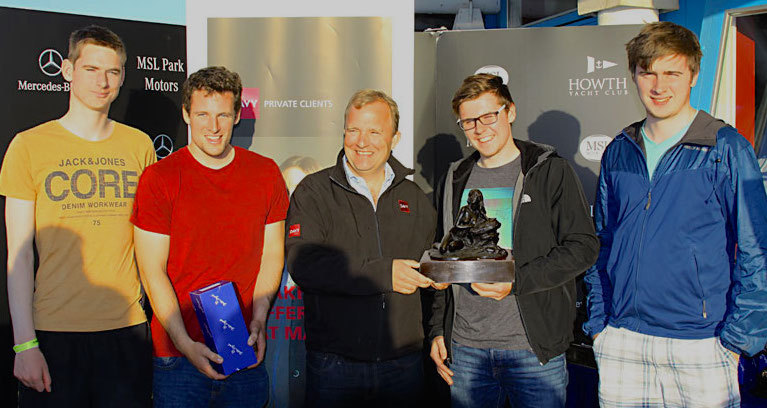
The highly-competitive Class 2 fleet saw Dave Cullen's half-tonner Checkmate XV emerge victorious in IRC to win the Heineken Trophy and Dermot Skehan's Toughnut finished ahead of Colm Birmingham's Bite the Bulletin the ECHO division. In Class 1, it was business-as-usual for Pat Kelly and the team on his J109 Storm, winning the Juno Cup for IRC as well as the Longyearbyn Trophy for best Howth boat, while the Boyd Cup for ECHO went to the Breen/ Gregory/ Hogg team on Flashback.
Other special trophies included the Whelan Cup for the leading Beneteau First 31.7 which was won by C'est la Vie, The Knights Trophy for J24s was won by the other K25 Squad in Johnny Bravo and the E-Boat prize went to Pat O'Neill's OctopussE.
On the Inshore Course, PRO Susan Cummins ensured that the Puppeteers, Squibs and Howth Seventeens got their money's worth with almost 3 hours of racing in the superb weather and conditions. Alan Pearson's Puppeteer Trick or Treat managed to get a valuable win which put his boat on top of the Scratch division, while a win by Gerry Kennedy's Schiggy closes the gap to 3 points from Handicap division leader Yellow Peril. The ISA Sailfleet J80s miss racing for this and next week because of their date with the All Ireland Helmsmans Championships in the NYC next weekend. In the Squibs, Jeff Kay's Chatterbox won the scratch prize for a second week in a row and shares top spot in the Handicap division with Roxanne.
In the Howth Seventeen class, Peter Courtney's Oona crossed the line first with only 30 seconds remaining before the time limit and the resulting time extension enabled all but previous series leader 'Isobel' finish the race.
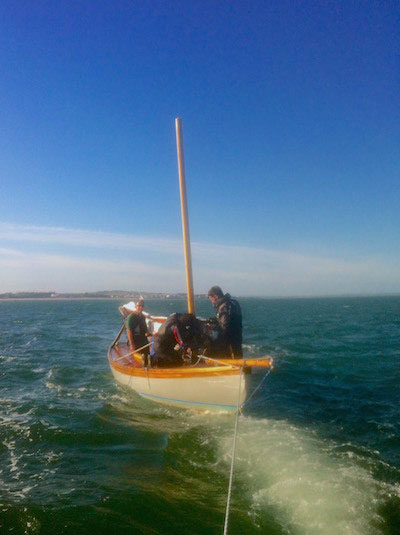
Isobel was unfortunate to be de-masted on the final leg
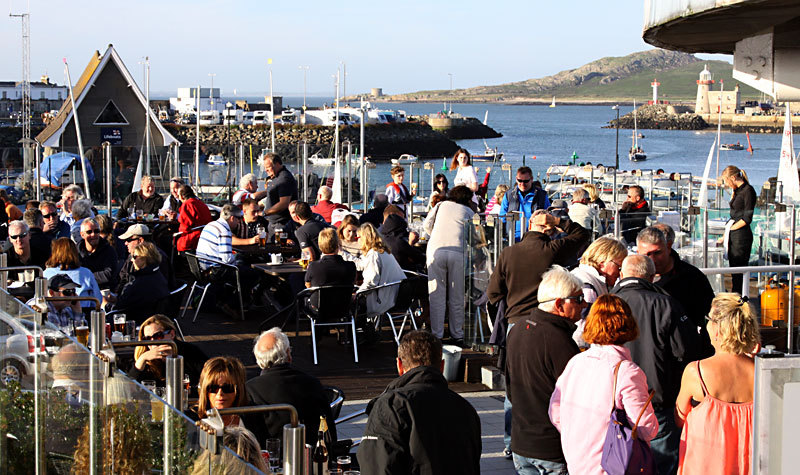
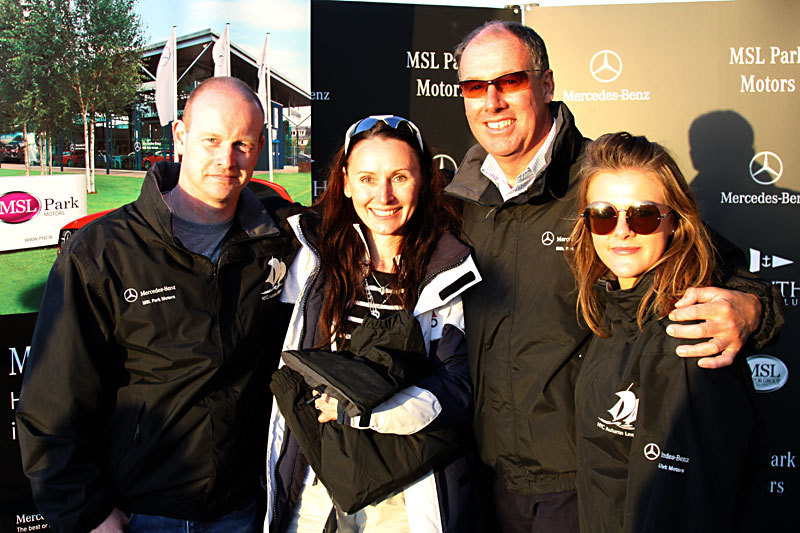
Squib Title Settled in Howth After Three–Way Tie
#squib – A three-way tie at the top of the 2015 Squib Nationals leaderboard was settled in favour of David Jones and Mark Hogan from South Caernarvonshire Yacht Club writes Emmet Dalton. Saturday's final race was led from start to finish by the duo. That race saw the second overall going to their clubmates Nigel Harris and John Stephenson. The champagne-splashed podium was completed by Malcolm Hutchings and Andy Ramsey from Royal Corinthian Yacht Club.
On the final day, Principal Race Officer, David Lovegrove, set the fleet off under the U-Flag penalty system after some misbehaving during the first attempt. The 20kt southeasterly breeze in glorious Howth sunshine, with five 1,700m windward legs, made sure that the crews got their bang for buck. Without exception, "Squib Arse" was suffered by hard-hiking sailors! The visiting sailors would later express their gratitude to David for his skill and engagement with a fleet that enjoyed his communicative banter on the VHF all during the week.
The event was made all the more epic by the championship dinner. Even the traditional Howth Seventeen Footer Class would have been impressed by the array of precious metals and rare timbers presented. Top Irish boat was "Aficionado" (RNIYC), hard driven by John Driscoll and David Cagney to 9th place. The leading HYC Squib was the super-slippery "Kerfuffle" in the hands of Emmet Dalton and Neal Merry which ended the week in 22nd place.
Woe betide anyone who thinks that grey (or no) hair indicates an easy crew to pass. Such was the quality of the fleet that one previous champion noted that he would have been happy to end up in the top ten at the end of the week!
Howth looked fabulous in a week of sun and the competitors enjoyed a warm welcome from the members and fabulous food and service. So good was the championship dinner that the Squib Association Chairman announced that it was the best meal at any Squib Championships in 40 years! That opinion was roundly applauded by the 130 guests.
Thanks was also expressed to the Race Office team, Orla Sweeney, Dara and Lara Jameson, Emma Inglis and Alice Kissane and to the ever-watchful Fergus O'Kelly and his group of friendly tape-wielding equipment inspectors for ensuring that each boat complied with the rules.
Launching, berthing and retrieval of the boats was coordinated like a North Korean political rally by Pat McCaughey. Slick!
Finally, the top speed of the week was shared by "Alchemy" from Royal Yorkshire Yacht Club and Howth's "Kerfuffle" both hitting 10.2kts during Monday's screaming reaches.
Additional reporting Vincent Delany
SQUIB NATIONALS 2015- day 6- Final Day.
The level and depth of talent in the 49 boat National Squib fleet was seen in today's race off Ireland's Eye at Howth. The wind was between 15 and 20 knots from the south-east. The outcome of the Squib Championship 2015 was yet to be decided. The three leading contenders being Malcolm Hutchings and Andy Ramsay from R.C.Y.C. in 'Lady Penelope', on 12 points, Nigel Harris and John Stephenson. S.C.Y.C., in 'Banshee', on 14 points, and David Jones and Mark Hogan, from S.C.Y.C. in 'Ric O'Shea', on 20 points. Which of these talented sailors had the ability to pull the championship out of the bag?
Unusually, the scoring system used allowed for two discards in eight race series. Would the winner be an older boat such as 'Banshee', no.65, or 'Ric O'Shea', no.136, or would it be the newer boat, 'Lady Penelope', no. 819? There was another significant variable in the mix, would the winner use Batt Sails or Hyde Sails? 'Ric O'Shea' is the only one of the three to use a complete wardrobe of Batt Sails the others only use Hyde Sails.
The course selected by race officer Dick Lovegrove was Course Number Two, a windward-leeward race of with five beats of 1.7km. each. The sea conditions were a little 'lumpy', and the tide was due to change mid-race.
On the start line the tide was flowing against the Squibs, which enabled the fleet to start on their first attempt, without recourse to the 'U' flag, which had been used for most of the races earlier in the week. The race officer did not use the dreaded 'black flag' at any race this week.
On the first beat against the tide it was 'Ric O'Shea' which appeared to get the bit between their teeth. The wind was steady in strength and direction, so it was a boatspeed race. At the first windward mark 'Ric-O-Shea' led from Gerard Dyson and Tony Saltonstall in 'Alchemy'. The locally Howth based 'Too Dee' sailed by Dave and Simon Sheahan rounded the mark within the top six boats. 'Banshee' rounded in about eighth place and 'Lady Penelope' about five places behind. These two had a lot of work to do, it was going to be a long nine mile race. On each round 'Ric O'Shea' sailed to her pre-determined tactical plan, and increased her lead until she was more than 100m. ahead of the bunch of Squibs following. 'Crossfire' sailed by Dave Best and Pete Richards worked their way into second place.
At the last leeward gate marks it appeared that 'Lady Penelope' had done enough to take her place on the podium and lift the championship trophy. But there was still one more beat to be completed, and the tide had turned. 'Lady Penelope' and 'Banshee' rounded different leeward gate marks, and by the end of the beat at the finish line, 'Banshee' had overhauled her opponent. As they passed the finish line the order was:
1st. 'Ric O'Shea', 136, David Jones and Mark Hogan, S.C.Y.C.
2nd. 'Crossfire' 797, Dave Best and Pete Richards, S.C.Y.C.
3rd. 'Alchemy', 800, Gerard Dyson and Tony Saltonstall, R.Y.Y.C.
4th.'Helmut Shoing II', Nigel and Jack Grogan, R.C.Y.C.
5th. 'White Magic', David Wines and Keith Davies, W.H.S.C.
6th. 'Moonstone', Malcolm Blackburn and David Shiel, S.C.Y.C.
7th. 'Pani-Munta', Mike Probert and Richard Delves, R.C.Y.C.
8th. 'Banshee', Nigel Harris and John Stephenson. S.C.Y.C.
9th. 'Lady Penelope', Malcolm Hutchings and Andy Ramsay. R.C.Y.C.,
So, who had won the championship?
Remarkably after eight races and two discards, 'Ric O'Shea', 'Banshee', and 'Lady Penelope' were all on equal points. Each had 21 points after discards.
'Ric O'Shea' discarded a 15th. and 21st. place. 'Lady Penelope' discarded 25th. and 26th. places. 'Banshee' discarded an 8th. and 29th. These figures are not relevant under the current scoring system, where a draw is resolved by the highest place boat in the last race which, as noted above, was won by 'Ric O'Shea.
RESULTS OF THE NATIONAL SQUIB CHAMPIONSHIP 2015.
1st. 1st. 'Ric O'Shea', 136, David Jones and Mark Hogan, S.C.Y.C.
2nd. 'Banshee', 65, Nigel Harris and John Stephenson. S.C.Y.C.
3rd. 'Lady Penelope', 819, Malcolm Hutchings and Andy Ramsay. R.C.Y.C.,
The top Irish Squib is 'Aficionado', 78, John Driscoll and David Cagney in 9th place.
Of the top ten places overall, 4 were from South Caernarvonshire Y.C., 4 were from Royal Corinthian Y.C., one from Royal North of Ireland Y.C., and one from Royal Yorkshire Yacht Club, which indicates that strong fleets at the local clubs are significant to developing the boatspeed necessary to win championship races under all conditions.
The top lady helmsman is Megan Pascoe with crew Hannah Stodel in 'Squibble' from Weymouth who finished in 31st. place. Their performance in this fleet is commendable. The also won the trophy for the top 'ParaSquibbers'. They were thrilled by the friendly and welcoming atmosphere which exists in the Squib fleet. They are newcomers in this fleet, and are more accustomed to the 2.4m. class, and Sonar parolympic circuits.
Annalise in Top Three at ISAF World Cup, Weymouth
#isafworldcup – Annalise Murphy is in the top three of the women's Laser Radial fleet at the ISAF World Cup fleet in Weymouth after today's two opening races in an 'uncommon' 15–knot easterly breeze. The Dun Laoghaire star scored a second in the first race and a sixth this afternoon in her 36–boat fleet. 16–year–old Aoife Hopkins of Howth Yacht Club, who earned her place by virtue of her performance (40th overall in an 82–boat fleet) at last month's Delta Lloyd regatta in Holland, lies 35th.
Belfast Lough's Ryan Seaton and Matt Mc Govern are 27th from 39th in the 49er skiff dinghy after counting a 13 and a disappointing 35 this afternoon.
In the women's skiff, Royal Irish pair Andrea Brewster and Saskia Tidey are scored as 'did not compete' in the first three races of the 49erFX class. Unfortunately the Dun Laoghaire pair were unable to race as a result of Tidey's 'suspected food poisoning' or 'some sort of vomiting bug'.
Ranging from 10-15 knots, the breeze coupled with glorious sunshine, resulted in some exceptional racing on the 2012 Olympic waters.
The stakes have been described as high by the competitors competing in Great Britain and rightly so with internal Rio qualification battles on-going, ISAF Sailing World Cup honours, a share of the prize fund and Abu Dhabi Final spots up for grab.
Racing commenced at 11:00 local time and wrapped up early evening with the ten Olympic, three Paralympic and Kiteboarding events completing their race schedule.
Laser
New Zealand's Andy Maloney came out with intent in the Laser, taking the day one lead with a strong performance as he explained, "We had good breeze between 10 and 15 knots. It was pretty shifty on the course but I had good pace and played the shifts and managed to come away with a first and second which is pretty solid. It was a good day."
The Road to Rio is a hard one and as well as international threats, Maloney also has to contend with domestic rivals on his journey. With the likes of his compatriots Sam Meech, Mike Bullot and Thomas Saunders all capable of challenging for medals, Maloney feels no internal pressure, "It's good for us and the Australians to have a good squad and we're all pushing each other hard.
"It's exciting more than anything now in the Laser because it's coming down to the final part of the cycle so it's crunch time now."
Yachting New Zealand named six crews for the Olympic Test Event on 18 May – see release here - . And as stated, will consider nominations the Laser following the World Cup Weymouth and Portland. A good performance by Maloney could go a long way for selection with Bullot in 15th, Saunders 20th and Sam Meech 21st after the opening day.
Nick Thompson (GBR) was not far off of Maloney's pace, finishing behind him in both races to sit in second.
London 2012 Olympic silver medallist Pavlos Kontides (CYP) was almost as strong in Weymouth and Portland's conditions as he did so well three years prior. A seventh and a fourth puts him third overall but he's got his eye on the top, "I'm satisfied with my performance and races today but there's still a long way to go and I hope to move up. Having 40 top guys with this new ISAF World Cup, the stakes are high.
"You have to push to the end and every race counts. You can win this event without winning any races. Consistency will prove vital in the end."
The day's remaining race win went the way of Jesper Stalheim (SWE) who is fourth overall.
Laser Radial
The last time Marit Bouwmeester (NED), Evi Van Acker (BEL) and Annalise Murphy (IRL) competed against each other at Weymouth and Portland they were locked in a battle for Olympic medals.
Fast forward three years and they're fighting it out again at the ISAF Sailing World Cup.
Marit Bouwmeester (NED) was assertive on the race course, winning both races by a comfortable margin. The Dutch sailor, who won silver at London 2012, sits atop the pile with Evi Van Acker, London 2012 bronze medallist, trailing on five points following a 3-2 scoreline.
Murphy came through in second in the opening race and followed it up with a sixth in Race 2. She is third on eight points.
Great Britain's Alison Young sits fourth on 13 points.
49er and 49erFX
On the face of the 49er results it would be quick to assume that leaders Lukasz Przybytek and Pawel Kolodzinski (POL) were the stand out performers of the day. However, regattas aren't won on the first they. It takes a consistent performance across five days of racing to come out on top and the most consistent team of the day were the first placed John Pink and Stu Bithell (GBR).
The pair recorded a 8-3-9 scoreline and were the only team to record three single digit scores. "On the first day of the regatta it's always nice to start well and we're thrilled to bits with three top tens. We're fifth overall which is great and tomorrow brings another challenge because it's going to be windy and we'll be pushing on and hopefully get into that top three.
"It's a great fleet, the top boats in the world are here and no one is really missing. It's great that everyone is competing in the ISAF Sailing World Cup."
Bithell won silver in the Men's 470 at London 2012 and on his home waters he knows what the venue is all about, "You could argue that I know Weymouth fairly well," he said with a smile. "I've lived here for some years now, did the Olympic Games here and is there a home advantage," he pondered, "yes there probably is but incidentally we don't always get the wind direction we had today."
The Polish crew lead on seven points with Pink and Bithell four points off the leaders. Nathan Outteridge and Iain Jensen (AUS) and Dylan Fletcher and Alain Sign (GBR) are tied on 8 points in second and third.
Maiken Foght Schutt and Anne-Julie Schutt (DEN) lead the way in the 49erFX on three points following scores of 6-2-1. Alex Maloney and Molly Meech (NZL) follow in second place on six points.
Sarah Steyaert and Aude Compan (FRA), Tamara Echegoyen and Berta Betanzos (ESP) and Martine Grael and Kahena Kunze (BRA) are tied on seven points from third to fifth.
Men's and Women's RS:X
It's a British 1-2 in the Men's RS:X and Women's RS:X. Nick Dempsey and Tom Squires are locked on three points apiece in the men's whilst Isobel Hamilton leads Bryony Shaw by a single point in the women's.
From three races Dempsey and Squires took a race victory each with the third place Mattia Camboni (ITA) taking the other.
"We had nice racing, very close," exclaimed Dempsey. "Tom and I are quicker than the fleet. Our training's gone really well and we're starting to sail well. It's nice and quite good fun racing."
The pair train together on a daily basis which has helped them in the build-up to the regatta as Dempsey explained, "It's nice having a competitive training partner. When we train we know we're training against one of the fastest people in the world.
"You never have to compensate. If you're beating Tom then you know you're going fast. That is what we've always missed having with our training partners so it's brilliant news."
"It's nice and quite good fun racing Tom."
In the Women's RS:X, Hamilton enjoyed a solid day on the water, staying at the front of the pack notching up a 6-2-2 scoreline. "It was definitely my best first day at a World Cup so far," said the smiling Hamilton, "I would love to be able to hold on to first for the whole week.
"It was really good racing and it's really nice to be racing at home. Weymouth is a fantastic venue and it's really great to be back here."
Shaw is a point off of Hamitlon after her 4-1-4 with London 2012 Olympic silver medallist Tuuli Petaja-Siren third overall. The day's race wins went to Joanna Sterling (AUS), Shaw and Ingrid Puusta (EST).
Finn
Andrew Murdoch (NZL) opened his Weymouth and Portland account with a strong display in the Finn, notching up a 3-2 to lead the 24-boat fleet.
Murdoch, a 2012 OIympian in the Laser, used his experience to full effect at the front of the fleet. He has opened up a four point lead over Jonathan Lobert (FRA).
Giles Scott (GBR) took the opening race victory of the day and followed it up with a 12th. He is third overall. The remaining race victory went the way of Josh Junior (NZL) who is sixth overall but just three points off the third placed Scott.
Men's and Women's 470
It's like London 2012 repeated in the Women's 470 with the gold and silver medallists occupying the spots they claimed three years ago.
Gold medallists Jo Aleh and Polly Powrie (NZL) dominated the day by taking both bullets whilst silver Hannah Mills and Saskia Clark (GBR) were forced to look at the back of the Kiwi boat in both races as they settled for two seconds.
Tina Mrak and Veronika Macarol (SLO) sit in third after the opening two races following a 4-3.
In the Men's 470, Stu McNay and David Hughes (USA) have a tasty six point lead over World #1 Panagiotis Mantis and Pavlos Kagialis (GRE). A fourth and a second gives them the lead at the early stage but with their experience, they won't be getting carried away.
Victories on the day went to the Greeks and Ferdinand Gerz and Oliver Szymanski (GER) who are sixth overall.
Nacra 17
As of 19:20 local time Thomas Zajac and Tanja Frank (AUT) lead the way in the Nacra 17. However, many of the competitors sailed the wrong course in Race 1 with Race Committee protests and vice versa. A handful of protests remain open that may result in further amendments.
As it stands the Austrians top the pile on four points followed by Matias Buhler and Nathalie Brugger (SUI) and Jason Waterhouse and Lisa Darmanin (AUS).
Paralympic Events
London 2012 Paralympic gold medallist Helena Lucas (GBR) began her World Cup campaign with intent. Double bullets give her a two point lead over Antonio Squizzato (ITA) who finished directly behind the Briton in both of the days races.
Malaysia's Al Mustakim Matrin sits in third overall.
In the SKUD18, Marco Gualandris and Marta Zanetti (ITA) and Alexandra Rickham and Niki Birrell (GBR) are level on three points.
The Italian and British teams shared the top two places on the day, taking a bullet and a second apiece.
Will Street and Megan Pascoe (GBR) are third overall.
It is tight at the top in the Sonar with four crews locked on five points.
Norway's Aleksander Wang-Hansen, Marie Solberg and Per Eugen Kristiansen took the opening bullet of the day and followed it up by a fourth.
John Robertson, Hannah Stodel and Steve Thomas (GBR) took the second bullet of the day but like the Norwegians also count a fourth.
Colin Harrison, Jonathan Harris and Russell Boaden (AUS) and John Twomey, Austrin O'Carroll and Ian Costelloe (IRL) notched up a second and a third each and are also tied with the Norwegian and Irish crews.
Racing resumes at 11:00 local time on Thursday 11 July with some great race action on the cards.
Howth's Lambay Race Cancelled Due to Strong Winds
#hyc – Disappointment in Howth Yacht Club this afternoon after the cancellation of its eagerly anticipated Lambay race was scrubbed because of strong westerly winds. The Howth fixture is the second major sailing fixture in the Capital's waters to fall victim to today's weather. Earlier, Dublin Bay Sailing Club scrubbed club racing for an estimated 200 boats off Dun Laoghaire.




























